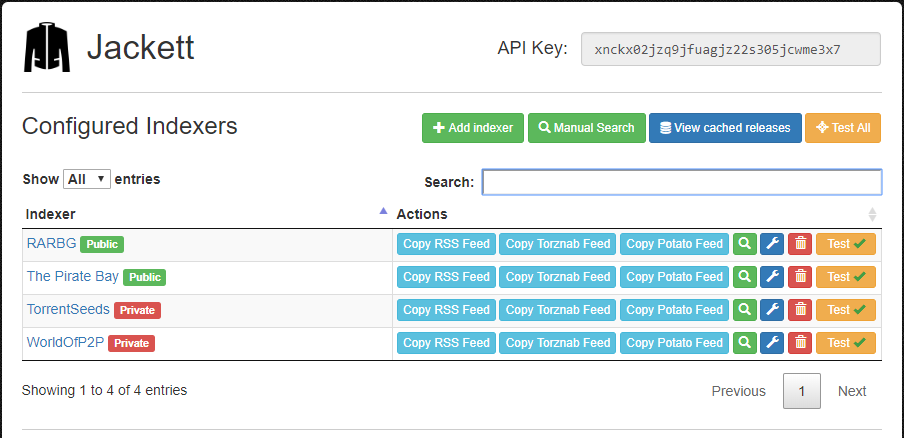Jackett, WireGuard and OpenVPN
Docker container which runs the latest headless Jackett Server while connecting to WireGuard or OpenVPN with iptables killswitch to prevent IP leakage when the tunnel goes down.

Docker Features
- Base: Debian bullseye-slim
- Latest Jackett
- Selectively enable or disable WireGuard or OpenVPN support
- IP tables kill switch to prevent IP leaking when VPN connection fails
- Configurable UID and GID for config files and /blackhole for Jackett
- Created with Unraid in mind
Run container from Docker registry
The container is available from the Docker Hub, which is the simplest way to get it. To run the container use this command, with additional parameters, please refer to the Variables, Volumes, and Ports section:
$ docker run --privileged -d \
-v /your/config/path/:/config \
-v /your/downloads/path/:/blackhole \
-e "VPN_ENABLED=yes" \
-e "VPN_TYPE=wireguard" \
-e "LAN_NETWORK=192.168.0.0/24" \
-p 9117:9117 \
--restart unless-stopped \
dyonr/jackettvpnVariables, Volumes, and Ports
Environment Variables
| Variable | Required | Function | Example | Default |
|---|---|---|---|---|
VPN_ENABLED |
Yes | Enable VPN? (yes/no) | VPN_ENABLED=yes |
yes |
VPN_TYPE |
Yes | WireGuard or OpenVPN? (wireguard/openvpn) | VPN_TYPE=wireguard |
openvpn |
VPN_USERNAME |
No | If username and password provided, configures ovpn file automatically | VPN_USERNAME=ad8f64c02a2de |
|
VPN_PASSWORD |
No | If username and password provided, configures ovpn file automatically | VPN_PASSWORD=ac98df79ed7fb |
|
WEBUI_PASSWORD |
Yes | The password used to protect/access Jackett's web interface | WEBUI_PASSWORD=RJayoLnKPjeyHbo-_ziH |
|
LAN_NETWORK |
Yes (atleast one) | Comma delimited local Network's with CIDR notation | LAN_NETWORK=192.168.0.0/24,10.10.0.0/24 |
|
NAME_SERVERS |
No | Comma delimited name servers | NAME_SERVERS=1.1.1.1,1.0.0.1 |
1.1.1.1,1.0.0.1 |
PUID |
No | UID applied to config files and blackhole | PUID=99 |
99 |
PGID |
No | GID applied to config files and blackhole | PGID=100 |
100 |
UMASK |
No | UMASK=002 |
002 |
|
WEBUI_PORT |
No | Sets the port of the Jackett server in the ServerConfig.json, needs to match the exposed port in the Dockerfile | WEBUI_PORT=9117 |
9117 |
HEALTH_CHECK_HOST |
No | This is the host or IP that the healthcheck script will use to check an active connection | HEALTH_CHECK_HOST=one.one.one.one |
one.one.one.one |
HEALTH_CHECK_INTERVAL |
No | This is the time in seconds that the container waits to see if the internet connection still works (check if VPN died) | HEALTH_CHECK_INTERVAL=300 |
300 |
HEALTH_CHECK_SILENT |
No | Set to 1 to supress the 'Network is up' message. Defaults to 1 if unset. |
HEALTH_CHECK_SILENT=1 |
1 |
ADDITIONAL_PORTS |
No | Adding a comma delimited list of ports will allow these ports via the iptables script. | ADDITIONAL_PORTS=1234,8112 |
Volumes
| Volume | Required | Function | Example |
|---|---|---|---|
config |
Yes | Jackett and OpenVPN config files | /your/config/path/:/config |
blackhole |
No | Default blackhole path for saving magnet links | /your/blackhole/path/:/blackhole |
Ports
| Port | Proto | Required | Function | Example |
|---|---|---|---|---|
9117 |
TCP | Yes | Jackett WebUI | 9117:9117 |
Access the WebUI
Access http://IPADDRESS:PORT from a browser on the same network. (for example: http://192.168.0.90:9117)
Default Info
API Keys are randomly generated the first time that Jackett starts up. There is no Web UI password configured. This can be done manually from the Web UI.
| Credential | Default Value |
|---|---|
API Key |
Randomly generated |
WebUI Password |
No password |
How to use WireGuard
The container will fail to boot if VPN_ENABLED is set and there is no valid .conf file present in the /config/wireguard directory. Drop a .conf file from your VPN provider into /config/wireguard and start the container again. The file must have the name wg0.conf, or it will fail to start.
How to use OpenVPN
The container will fail to boot if VPN_ENABLED is set and there is no valid .ovpn file present in the /config/openvpn directory. Drop a .ovpn file from your VPN provider into /config/openvpn (if necessary with additional files like certificates) and start the container again. You may need to edit the ovpn configuration file to load your VPN credentials from a file by setting auth-user-pass.
Note: The script will use the first ovpn file it finds in the /config/openvpn directory. Adding multiple ovpn files will not start multiple VPN connections.
Example auth-user-pass option for .ovpn files
auth-user-pass credentials.conf
Example credentials.conf
username
passwordPUID/PGID
User ID (PUID) and Group ID (PGID) can be found by issuing the following command for the user you want to run the container as:
id <username>Issues
If you are having issues with this container please submit an issue on GitHub. Please provide logs, Docker version and other information that can simplify reproducing the issue. If possible, always use the most up to date version of Docker, you operating system, kernel and the container itself. Support is always a best-effort basis.

